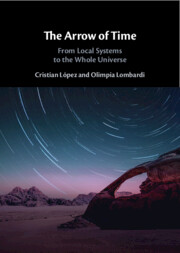Refine search
Actions for selected content:
279 results

Quasar Absorption Lines
-
- Published online:
- 17 December 2025
- Print publication:
- 18 December 2025
Saprobic politics: Decomposing colonial cosmologies in international relations
-
- Journal:
- Review of International Studies , First View
- Published online by Cambridge University Press:
- 11 December 2025, pp. 1-21
-
- Article
-
- You have access
- Open access
- HTML
- Export citation

Quasar Absorption Lines
-
- Published online:
- 10 December 2025
- Print publication:
- 18 December 2025
Geometrical Heuristics for the Political Cosmology of Huainanzi 淮南子
-
- Journal:
- Early China , First View
- Published online by Cambridge University Press:
- 24 November 2025, pp. 1-44
-
- Article
-
- You have access
- Open access
- HTML
- Export citation
Chapter 8 - The House of Spirits
- from Part II - Ethnography
-
- Book:
- Shapes in Revolution
- Published online:
- 07 November 2025
- Print publication:
- 20 November 2025, pp 238-264
-
- Chapter
- Export citation
13 - Finding Time for Wheeler–DeWitt Cosmology
- from Part IV - The Whole Universe
-
-
- Book:
- The Arrow of Time
- Published online:
- 28 October 2025
- Print publication:
- 30 October 2025, pp 267-296
-
- Chapter
- Export citation
11 - Following Earman’s Time Direction Heresy: From the Global Arrow of Time to Local Irreversible Processes
- from Part IV - The Whole Universe
-
-
- Book:
- The Arrow of Time
- Published online:
- 28 October 2025
- Print publication:
- 30 October 2025, pp 225-249
-
- Chapter
- Export citation

The Arrow of Time
- From Local Systems to the Whole Universe
-
- Published online:
- 28 October 2025
- Print publication:
- 30 October 2025
6 - Episodes in Rival Narratives
-
- Book:
- The Narrative Conflict of Traditions in the Late Antique World
- Published online:
- 22 September 2025
- Print publication:
- 09 October 2025, pp 198-229
-
- Chapter
- Export citation
Chapter 4 - Opposites in the Cosmology of Magna Graecia
-
- Book:
- Aggregation and Antithesis in Ancient Greece
- Published online:
- 21 October 2025
- Print publication:
- 28 August 2025, pp 63-113
-
- Chapter
- Export citation
Against American Ethnic Democracy: White Rule and Black Rebellion
-
- Journal:
- Perspectives on Politics , First View
- Published online by Cambridge University Press:
- 07 August 2025, pp. 1-18
-
- Article
-
- You have access
- Open access
- HTML
- Export citation
Chapter 6 - The Recurring Cosmos
-
- Book:
- The Stoic Cosmos
- Published online:
- 08 July 2025
- Print publication:
- 24 July 2025, pp 174-212
-
- Chapter
- Export citation
Chapter 8 - Concluding Remarks
-
- Book:
- The Stoic Cosmos
- Published online:
- 08 July 2025
- Print publication:
- 24 July 2025, pp 247-262
-
- Chapter
- Export citation
Chapter 2 - The Conflagration
-
- Book:
- The Stoic Cosmos
- Published online:
- 08 July 2025
- Print publication:
- 24 July 2025, pp 35-63
-
- Chapter
- Export citation
Chapter 3 - Presocratic Antecedents of the Stoic Conflagration
-
- Book:
- The Stoic Cosmos
- Published online:
- 08 July 2025
- Print publication:
- 24 July 2025, pp 64-96
-
- Chapter
- Export citation
Chapter 4 - The Cosmogony
-
- Book:
- The Stoic Cosmos
- Published online:
- 08 July 2025
- Print publication:
- 24 July 2025, pp 97-124
-
- Chapter
- Export citation
Chapter 5 - The Metaphysics of Everlasting Recurrence
-
- Book:
- The Stoic Cosmos
- Published online:
- 08 July 2025
- Print publication:
- 24 July 2025, pp 125-173
-
- Chapter
- Export citation
Introduction
-
- Book:
- The Stoic Cosmos
- Published online:
- 08 July 2025
- Print publication:
- 24 July 2025, pp 1-11
-
- Chapter
- Export citation
Chapter 7 - The Paradox of Destruction and Restoration
-
- Book:
- The Stoic Cosmos
- Published online:
- 08 July 2025
- Print publication:
- 24 July 2025, pp 213-246
-
- Chapter
- Export citation
Chapter 1 - Overview of the Stoic Cosmos
-
- Book:
- The Stoic Cosmos
- Published online:
- 08 July 2025
- Print publication:
- 24 July 2025, pp 12-34
-
- Chapter
- Export citation
